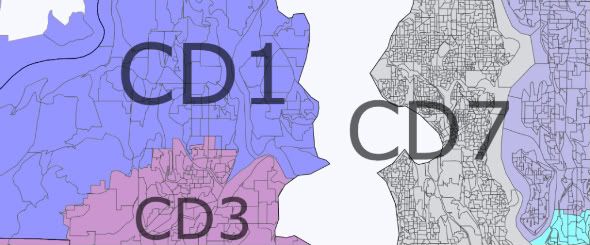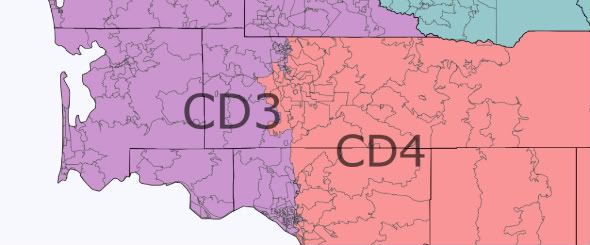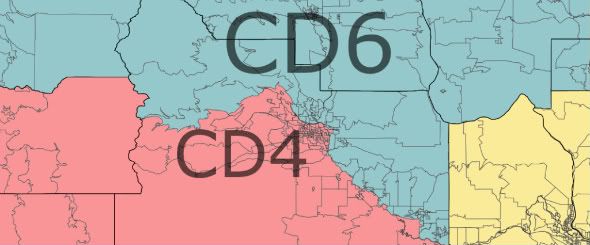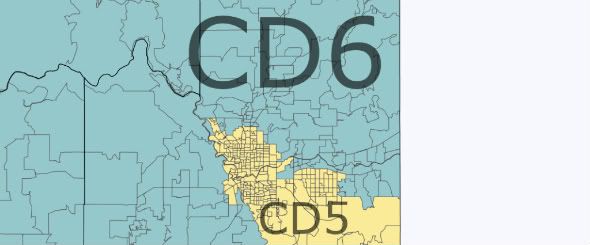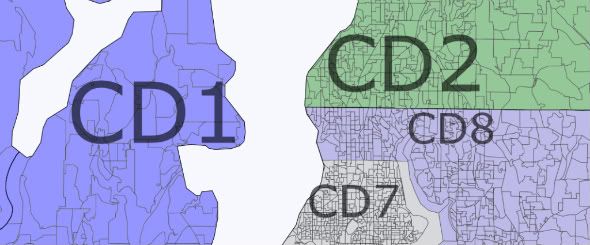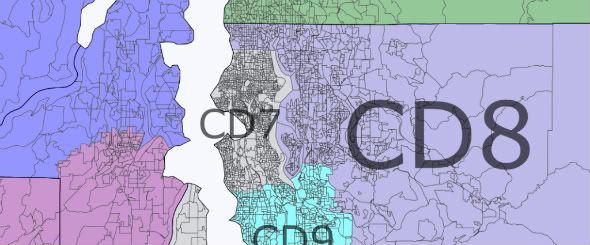The Census figures won’t be reported until December and not finalized until next spring, but the 2010 elections are now over and it seems redistricting is on everyone’s – and by everyone, I mean everyone in the rarefied world of political blogs and political science academia – minds. Republicans are crowing that their control of the redistricting trifectas in Florida, Georgia, Michigan, Ohio, Pennsylvania, Texas, and Wisconsin will bring them great gains and solidify their new House majority for years to come (funny, much the same was said in 2002, and House control has flipped twice since then, in dramatic numbers each time). So though it’s early, let’s look state-by-state at what is most likely to come of redistricting this decade.
I’m excluding some states – Alabama, Arkansas, Colorado, Connecticut, Hawaii, Idaho, Kansas, Kentucky, Maine, Maryland, Mississippi, Nebraska, New Hampshire, New Mexico, Oklahoma, Oregon, Rhode Island, Tennessee, and West Virginia – whose redistricting process will likely prove uninteresting this round.
Arizona
Who’s in control? Nonpartisan commission
How many seats? 9 (up from 8 in 2002)
Likely shift? +1 competitive seat
The Republicans have a 5-3 majority in Arizona’s delegation, but each party holds a couple generally competitive seats (the 1st and 5th for the Republicans, the 8th for the Democrats), and the commission needs not protect incumbents, so will probably seek to create as close to a tossup seat as possible in the fast-growing suburban areas of Maricopa County (Phoenix). As in 2002 when Rick Renzi’s win in the then-newly created 1st corresponded to slightly expanded Republican majorities nationwide, how the new Arizona seat goes may act as a bellwether of sorts.
California
Who’s in control? Nonpartisan commission
How many seats? 53
Likely shift? Totally up in the air
This state saw a genius Democratic gerrymander in 1982, a competitive court-drawn map in 1992, an incumbent protection gambit in 2002, and now nonpartisan redistricting has finally come to California. Republicans are convinced they can net a handful of seats out of a commission-drawn map, but remember we are talking about a presidential year in which Democratic turnout for Obama should be high and that some of the greatest beneficiaries of 2002’s map were suburban Republicans. Bottom line: no one knows what to expect.
Florida
Who’s in control? Republicans, within limits
How many seats? 27 (up from 25 in 2002)
Likely shift? We’ll see
A state constitutional amendment passed on November 2 that banned the legislature from drawing districts designed to favor or disfavor a given political party, so in essence the state is now subject to nonpartisan redistricting. However, the state government is still solidly in GOP control, so the legislature can easily pass a gerrymandered map and just wait for the Democrats to launch a time-consuming court challenge. Meanwhile, the amendment is itself being challenged in court right now by Reps. Corrine Brown and Mario Diaz-Balart, who claim that the new redistricting rules re: compactness jeopardize VRA-protected minority seats. If they win in court, the amendment is out and GOP gerrymandering is in. But should the legislature actually have to follow new rules, we could see quite a few Democratic pickups here, as the state is already ridiculously rigged in Republicans’ favor.
Georgia
Who’s in control? Republicans
How many seats? 14 (up from 13 in 2002)
Likely shift? +1-2 R
The only question is how aggressive Republicans want to be. If I were them, I’d craft a new GOP seat in Gwinnett County/eastern Atlanta and pack Sanford Bishop’s south Georgia seat with black population in Macon, then make John Barrow’s Augusta-to-Savannah marginal Dem district a bit more Republican. But if they overreach re: Barrow (or try to target Bishop instead) they could leave frosh GOPer Austin Scott underprotected.
Illinois
Who’s in control? Democrats
How many seats? 18 (down from 19 in 2002)
Likely shift? +2-3 D
The Democrats definitely plan to milk Illinois for all its worth, particularly given GOP gains this year that allow for some serious poaching and the lack of Democratic gerrymandering opportunities elsewhere. Expect a Republican – either Bobby Schilling downstate or Bob Dold/Joe Walsh in the Chicago area – to face elimination and another two (Randy Hultgren and Adam Kinzinger, e.g.) to see their districts cracked or reconfigured.
Indiana
Who’s in control? Republicans
How many seats? 9
Likely shift? +1 R
This is a simple enough task for the GOP: protect Larry Bucshon and Todd Young, defeat Joe Donnelly. For the latter purpose, moving Donnelly’s South Bend-area base into the already heavily Democratic 1st District would be all that is required.
Iowa
Who’s in control? Nonpartisan commission (with legislative approval)
How many seats? 4 (down from 5 in 2002)
Likely shift? Dem vs. GOP incumbent match
The nonpartisan commission likely won’t force two Democrats (Braley and Loebsack) or two Republicans (Latham and King) together, so the only plausible outcome, I think, is a match between Latham and Boswell in central Iowa around Des Moines and Ames. This will be a tossup district with maybe a slight edge given to Latham.
Louisiana
Who’s in control? Split (GOP Gov, Dem Legislature)
How many seats? 6 (down from 7 in 2002)
Likely shift? -1 R
The only Democratic seat left is Cedric Richmond’s VRA-protected 2nd District, which will likely regain lost population by adding a tentacle in Baton Rouge. A Republican – perhaps newcomer Jeff Landry – will have to be cut loose. If it’s Landry as some have suggested, he will be combined with Charles Boustany in a Cajun Country/Gulf-centered seat.
Massachusetts
Who’s in control? Democrats
How many seats? 9 (down from 10 in 2002)
Likely shift? -1 D
This cancels out Louisiana from a partisan standpoint. RealClearPolitics recently pointed out that the Western Mass 1st District, held by 70-something Rep. John Olver, seems a likely target for elimination but that liberals would much rather devise a way to get rid of Stephen Lynch in South Boston. And then, of course, there’s freshman Bill Keating. The decision may rest more on personality than on politics, given the lack of partisan intrigue innate to a bunch of veteran Democrats picking which veteran Democrat to force out of Congress.
Michigan
Who’s in control? Republicans
How many seats? 14 (down from 15 in 2002)
Likely shift? -1 D
Much speculation has centered on who the unlucky Democrat will be but I’m actually reasonably certain it will be two-termer Gary Peters in Oakland County. The Detroit area has lost population, but both VRA districts (Hansen Clarke’s 13th and John Conyers’ 14th) can and will be preserved, so the simplest solution is to combine Peters with longtimer Sander Levin in a heavily Democratic suburban seat. I doubt the Republicans will target Dingell or Kildee either, since that would spread GOP votes too thin in an already gerrymandered map.
Minnesota
Who’s in control? Split (Dem Gov, GOP Legislature) assuming Dayton wins the gov. race
How many seats? 7 (down from 8 in 2002)
Likely shift? Dem vs. GOP incumbent match
If Tom Emmer wins the gubernatorial recount, we are in for a whole new ballgame as Republicans finally combine Minneapolis and St. Paul into one district, but should Dayton prevail this may involve a competitive seat between Collin Peterson and Chip Cravaack up north or between Tim Walz and John Kline down south.
Missouri
Who’s in control? Split (Dem Gov, GOP Legislature)
How many seats? 8 (down from 9 in 2002)
Likely shift? Dem vs. GOP incumbent match
RealClearPolitics noted that the GOP’s legislative majorities are almost veto-proof and that, if black Democrats ally with Republicans, they could pass a GOP- and minority-friendly map over Gov. Nixon’s objections. But the most likely outcome here is a suburban St. Louis race between Todd Akin and Russ Carnahan that favors Akin (since Carnahan will need to cede some Democratic votes to Lacy Clay’s population-losing 1st District).
Nevada
Who’s in control? Split (GOP Gov, Dem Legislature)
How many seats? 4 (up from 3 in 2002)
Likely shift? +1 D
The legislature will probably pass a plan that protects newbie Republican Joe Heck but compensates with a new Dem-leaning seat in Reno or suburban Clark County.
New Jersey
Who’s in control? Bipartisan commission
How many seats? 12 (down from 13 in 2002)
Likely shift? Dem vs. GOP incumbent match
North Jersey’s population loss means Bill Pascrell could be combined with Rodney Frelinghuysen or Scott Garrett in a moderate suburban district. The commission is bipartisan, not nonpartisan, so swing votes can easily be swung and incumbent protection for the other 11 districts is almost assured.
New York
Who’s in control? Split (Dem Gov and House, GOP Senate)
How many seats? 27 (down from 29 in 2002)
Likely shift? 1 D and 1 R
I am assuming the Senate stays in Republican hands; this should involve the elimination of one upstate seat and one city-area seat. RCP predicts the unlucky upstater will be a Democrat and the unlucky downstater a Republican (Pete King or, if he wins, Randy Altschuler). But I always assumed it would be the opposite. In all predicted scenarios, incumbents of the same party will be combined with each other. We shall see.
North Carolina
Who’s in control? Republicans
How many seats? 13
Likely shift? +2 R
Republicans will seek to aggressively undo the Democratic gerrymander of ’02 by dismantling Larry Kissell and either Heath Shuler or Mike McIntyre. They could conceivably target all three and spread Republican votes extremely thin. David Price, Brad Miller, Mel Watt, and G.K. Butterfield should be fine in any case.
Ohio
Who’s in control? Republicans
How many seats? 16 (down from 18 in 2002)
Likely shift? 1 D and 1 R
I am convinced the GOP will not seek to eliminate two Democrats. That would, quite simply, jeopardize their incredibly lopsided majority in the state delegation. I’ve long thought they’d combine Dennis Kucinich and Betty Sutton in a new Cleveland-to-Akron seat and two freshman Republicans elsewhere (best bet? Bill Johnson and Bob Gibbs in the rural east, or Gibbs and Jim Renacci from Canton). Meanwhile, they’ll shore up regained GOP seats in Cincinnati and Columbus.
Pennsylvania
Who’s in control? Republicans
How many seats? 18 (down from 19 in 2002)
Likely shift? -1 D and possibly +1 R
As in Michigan and Ohio, we are already working with a GOP-gerrymandered map in the aftermath of a GOP-friendly election so the Republicans can’t afford to target the remaining Dem incumbents much. The most they can do is eliminate Mark Critz and make Jason Altmire’s seat more Republican.
South Carolina
Who’s in control? Republicans
How many seats? 7 (up from 6 in 2002)
Likely shift? +1 R
John Spratt’s defeat makes this an easy call- pack the black population and Democrats in general into Jim Clyburn’s 6th to squeeze out one more Republican seat either up north or near Charleston.
Texas
Who’s in control? Republicans
How many seats? 36 (up from 32 in 2002)
Likely shift? +3 R and +1 D
This is a fascinating case. The Republicans have unlikely freshmen in Quico Canseco and Blake Farenthold; how to protect them without diluting the Hispanic populations in the 23rd and 27th and thereby violating the VRA? Meanwhile, RCP is convinced they can carve out four new GOP districts, but every way I’ve run the math the Democrats are due a new seat in Dallas-Fort Worth. The scenario I suggest may actually be the best possible outcome for the Republicans, since if they protect Canseco and Farenthold too much they may see their map tossed out in court. One more parting shot: pack every available Hispanic into the already heavily Latino 29th to see if they can finally knock Gene Green out in a Democratic primary.
Utah
Who’s in control? Republicans
How many seats? 4 (up from 3 in 2002)
Likely shift? +1 R
The big question is whether the legislature will try once again to ruin Democratic survivor Jim Matheson, whose district is already heavily rural and ridiculously conservative, or just give him a moderate Salt Lake City-based district to ensure the election of three Republicans? It seems to me they can’t make his seat much more Republican without making the new 4th District a comparably liberal SLC seat.
Virginia
Who’s in control? Split (GOP Gov and House, Dem Senate)
How many seats? 11
Likely shift? None
At the moment everyone presumes we will see an incumbent protection map, but consider the following scenario: Republicans stall on redistricting until after the 2011 elections, hoping to flip control of the Senate and thereby run the whole process. They then draw a map the following year that cracks Gerry Connolly’s base and allows for a 9-2 GOP majority. Of course, that assumes the wind is still at Republicans’ backs next November, and a year is indeed an eternity in politics.
Washington
Who’s in control? Nonpartisan commission
How many seats? 10 (up from 9 in 2002)
Likely shift? +1 competitive
The commission is not obliged to protect incumbents, so anything can happen with the existing delegation or with the new 10th District. Both suburban Seattle and the inland have grown, and the two regions’ politics stand in stark contrast, so…we shall see.
Wisconsin
Who’s in control? Republicans
How many seats? 8
Likely shift? None or +1 R
The most they could do at this point is crack Ron Kind’s district, but that would represent a huge risk since Sean Duffy and Reid Ribble are new in town. Duffy, particularly, would benefit from Kind getting a more Democratic seat in western Wisconsin.











